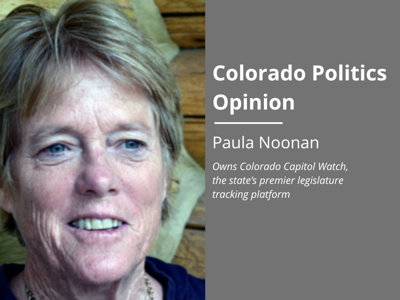
Paula Noonan
Colorado’s SB24-188, Public School Finance bill, was introduced last week. The appropriation puts a modest $10 billion toward educating about 880,000 students. The legislature thoughtfully added $416 per student to the total to settle Amendment 23’s constitutional requirements to cover inflation plus a little more.
Our public school finance system is notorious. We Coloradans are well-known as public education cheapskates. Policy-makers blame TABOR, but there are other issues that compound our collective negligence.
The interrelatedness of our exquisitely ineffective school funding formula, property taxes, state general fund contributions to districts, Charter School Institute funding and TABOR create a confusing mess.
Starting with local property tax vs. state general fund contributions to school finance, we can see the nature of the first-level distortions. In general, it would be helpful if each school district financed at least half of its budget with local dollars. As it is, some very generous taxpayers in some school districts fund 100% of their districts’ dollars. These 12 districts educate 12,096 students on their own dime at a total of $137 million.
Stay up to speed: Sign up for daily opinion in your inbox Monday-Friday
Another 13 districts educate their children using 80% of their own local money, accounting for $464 million of the state’s total school finance dollars. These districts educate another 49,237 students. We should all say, "BRAVO, NICELY DONE," because these districts have either raised their mills to the max or found other sources of money to cover what the state determines they need for per-student funding.
At the other end of the local school property tax funding puzzle is Colorado’s Charter School Institute (CSI) district at $0 local dollars contributed to its schools. CSI oversees and finances 43 charter schools out of the mill levy equalization fund because these schools don’t have a district home. The full state funding supports 23,013 students. If HB24-1394, Mill Levy Equalization Fund, passes this session, the mill levy funds source will move to the state’s general fund.
According to the 2023-2024 school finance budget, CSI schools received $223.32 million. When capital dollars are added, the total rises to $311.90 million The hundreds of millions in state money to CSI reduce funds that might otherwise be available to districts that do not have CSI schools.
CSI charters get facility deals from local districts because districts are required to lease their surplus buildings to CSI schools for $12 per year whether the districts want to or not. In this way, CSI schools appropriate local facilities for their state-funded charters.
CSI board member Ross Izard objects to the removal of this CSI benefit in a recently introduced charter school accountability bill, HB24-1363. But CSI schools overall produced a weak 58.1% average district performance rating in 2023 using CDE criteria. CDE’s SchoolView shows the district is just “approaching expectations” based on the state’s three measured performance elements.
In comparison, as charter schools like to match their excellent performance against the tawdry results of public schools, CSI’s district ranks four points below Jefferson County School District, six points below Cherry Creek School District, and 10 points below Douglas County School District.
Let’s move on to another school finance conundrum. Thirty-nine school districts fund 20% or less of their school district’s dollars. In these cases, the state pumps in money. That’s 67,717 students who receive the large majority of their school finance funding from the state.
In many cases, these districts have low-income residents or they are small rural districts that lack the financial efficiencies of larger districts. An exception is Falcon 49 with its $111,856 average household income and 25,267 student population. It receives a total of $308.77 million for its schools, of which $44.96 million comes from local property taxes and $263.81 million from the state general fund. The district matches the state average for minority students but educates significantly fewer English Language Learning students at 4%. Meanwhile, its Colorado Department of Education performance ranking is 45.3 — "Improvement" category.
So what’s creating this low academic performance ranking? At least some of the ranking relates to the Education-ReEnvisioned BOCES that the district supports as a mostly online venture of Executive Director Ken Witt who is also superintendent of Woodland Park School District. This BOCES is almost entirely funded by the state but has a 42.5 performance ranking, sinking the Falcon district’s results.
Falcon 49 is not the only large district that shows a significant gap between local property tax support and state equalization. Seventy-seven school districts fund 30% or less of their district obligation. Some of these districts, such as Academy 20, with much higher than the Colorado average of household income at $107,000, can probably afford to pay more. Academy 20 does produce a high performance ranking at 75.5% based on its school population of 32% minority students and 2% ELL.
These demographics are significant. Schools and districts with more than 15% ELL students find it almost impossible to achieve the state’s achievement and growth goals with tests in English given to students not fluent in English. This problem is compounded by the meager donation of $53 million to help about 150,000 students become English fluent in roughly two years. Adams 14 has 41% ELL students. That’s 2,200 kids. It received only $1.154 million extra to help with language learning.
Schools with high numbers of at-risk children are similarly stretched thin. Out of our $10 billion school finance budget, $576 million extra is allocated to these students. For districts like Englewood (87% local funding) and Sheridan (61% local funding), these dollars are insufficient to support their high numbers of Free and Reduced Lunch and ELL students.
The irony is as some low-income districts diligently raise more money locally to help their students, they see their state tax contribution go down by the same amount. Too many districts that by average household income can afford to pay more, don’t.
Not much will change in these numbers in the 2024-2025 school year based on this year’s school finance bill. Anyone in for some reform in 2025-2026?
Paula Noonan owns Colorado Capitol Watch, the state’s premier legislature tracking platform.









(0) comments
Welcome to the discussion.
Log In
Post a comment as Guest
Keep it Clean. Please avoid obscene, vulgar, lewd, racist or sexually-oriented language.
PLEASE TURN OFF YOUR CAPS LOCK.
Don't Threaten. Threats of harming another person will not be tolerated.
Be Truthful. Don't knowingly lie about anyone or anything.
Be Nice. No racism, sexism or any sort of -ism that is degrading to another person.
Be Proactive. Use the 'Report' link on each comment to let us know of abusive posts.
Share with Us. We'd love to hear eyewitness accounts, the history behind an article.